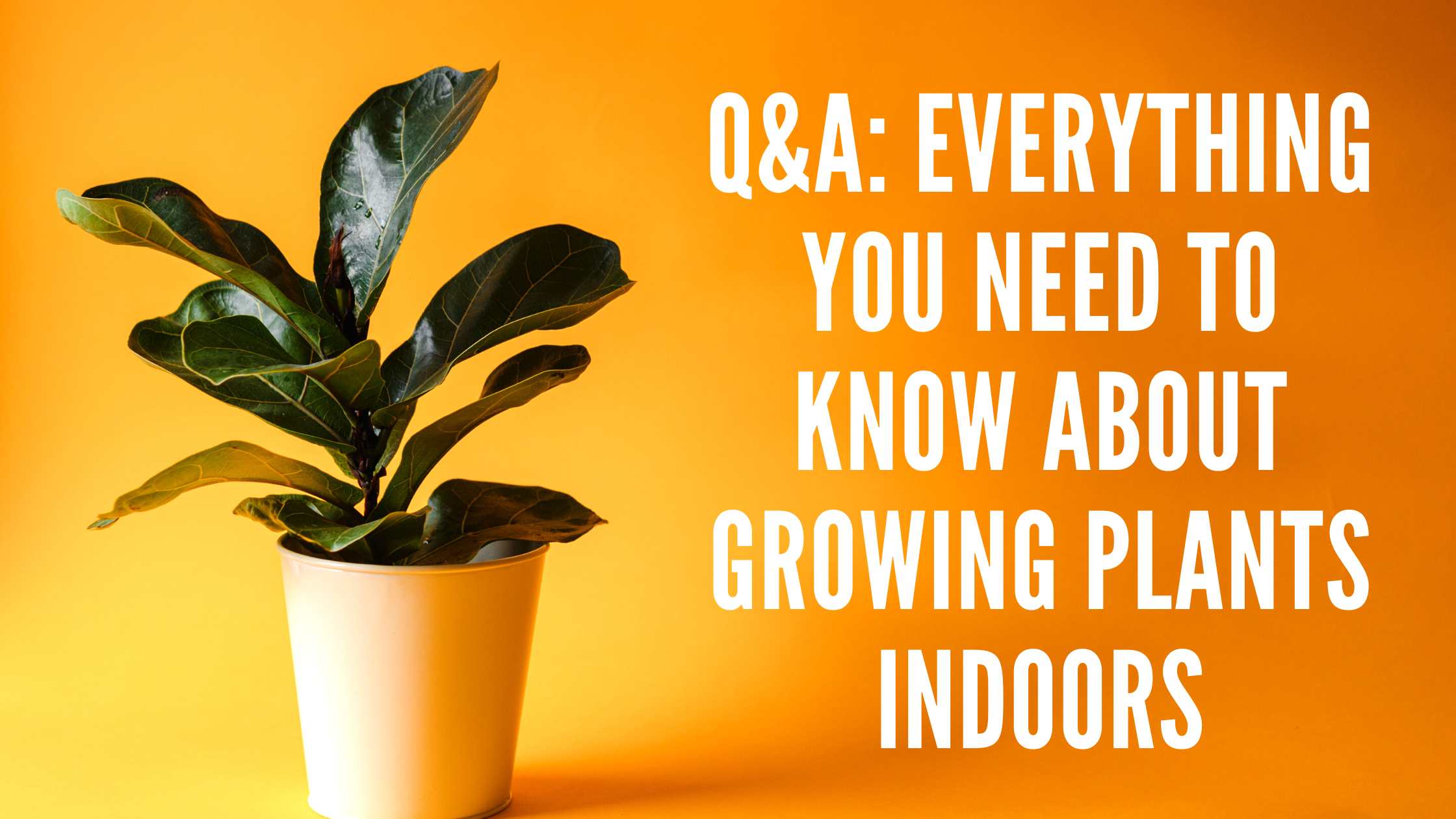Welcome to our blog post Q&A on growing plants indoors! Whether you are new to gardening or an experienced green thumb, there is something for everyone in this Q&A. We’ve gathered a bunch of your questions about indoor plants, from choosing the right plants for your home to proper care and maintenance.
Let us know in the comments if you like this format and i’ll try to do some more.
Q&A Questions
Q: Hey Ben, I’m new to gardening and I’m wondering what are some good plants to start with indoors? – Maria
A: Hi Maria, some good plants to start with indoors include herbs like basil and mint, as well as easy-to-care-for succulents like aloe vera and jade plants. These plants are generally low maintenance and can thrive in a variety of indoor environments.
Q: How do I know if my indoor plants are getting enough sunlight? – Jack
A: Hi Jack, it’s important to ensure that your indoor plants are getting enough sunlight as it is essential for their growth. One way to tell if your plants are getting enough sunlight is to observe their leaves. If the leaves are yellow or pale, it could be a sign that they are not getting enough sunlight. On the other hand, if the leaves are a vibrant green color and are growing well, it could be a sign that they are getting the right amount of sunlight.
Q: Can I grow fruit trees indoors? – Sarah
A: Hi Sarah, it is possible to grow some types of fruit trees indoors, but it can be more challenging as they typically require a lot of sunlight and space to grow. If you are interested in attempting to grow a fruit tree indoors, it is important to do your research and choose a variety that is suitable for indoor growing conditions.
Q: How often should I water my indoor plants? – Peter
A: Hi Peter, the frequency of watering your indoor plants will depend on a variety of factors such as the type of plant, the size of the pot, and the temperature and humidity of the room. As a general rule of thumb, it is a good idea to allow the soil to dry out slightly between watering, and then water your plants until the soil is moist but not soggy. Overwatering can be just as harmful as underwatering, so it is important to find a balance.
Q: What can I do if my indoor plants are not growing well? – Rachel
A: Hi Rachel, there could be a number of reasons why your indoor plants are not growing well. Some possible causes could include insufficient sunlight, improper watering, or pests. It is a good idea to carefully observe your plants and try to identify any potential issues. If you are unable to find a solution, it might be helpful to consult with a gardening expert or do some additional research online.
Q: Can I grow vegetables indoors? – David
A: Hi David, yes, it is possible to grow a variety of vegetables indoors. Some options include tomatoes, lettuce, and peppers. These plants can be grown in pots or containers and will need plenty of sunlight and proper care to thrive.
Q: How do I care for indoor plants during the winter months? – Emily
A: Hi Emily, during the winter months, it is important to ensure that your indoor plants are getting enough sunlight and water. As the days get shorter and the air becomes drier, you may need to adjust your watering and fertilizing routine. It is also a good idea to monitor the temperature and humidity levels in your home to make sure that your plants are not subjected to extreme conditions.
Q: What are some good plants to have in a bathroom? – Katie
A: Hi Katie, some good plants to have in a bathroom include ones that thrive in high humidity environments such as orchids, ferns, and peace lilies. These plants can help to purify the air and add a touch of greenery to your bathroom.
Q: How do I propagate plants from cuttings? – Sam
A: Hi Sam, propagating plants from cuttings is a simple and effective way to grow new plants. To propagate a plant from a cutting, start by selecting a healthy stem and cutting it off the parent plant. Next, remove the lower leaves and dip the cut end in rooting hormone. Finally, plant the cutting in a pot filled with soil or rooting medium, and keep it moist until new growth appears.
Q: Can I grow plants in a basement? – Jessica
A: Hi Jessica, it is possible to grow plants in a basement as long as you provide them with the necessary light and care. If your basement does not get enough natural light, you may need to use grow lights to provide your plants with the light they need to thrive. It is also important to pay attention to temperature and humidity levels, as well as watering and fertilizing needs.
Q: What are some plants that are good for purifying the air? – John
A: Hi John, there are a number of plants that are known for their air purifying qualities. Some options include spider plants, bamboo palms, and snake plants. These plants can help to remove toxins and improve the air quality in your home.
Q: How do I re-pot a plant? – Emily
A: Hi Emily, repotting a plant is a simple process that can help to rejuvenate your plant and encourage healthy growth. To repot a plant, start by selecting a pot that is a few inches larger than the current one, and fill it with fresh soil. Next, gently remove the plant from its current pot and loosen the roots before placing it in the new pot. Make sure to firm the soil around the plant and water it thoroughly after repotting.
Q: What are some good plants to have in a bedroom? – Rachel
A: Hi Rachel, some good plants to have in a bedroom include ones that can help to improve air quality and promote relaxation. Some options include lavender, jasmine, and valerian. These plants can help to reduce stress and promote a good night’s sleep.
Q: Can I grow plants on a windowsill? – Sarah
A: Hi Sarah, growing plants on a windowsill can be a great way to bring a touch of nature into your home. Some good options for windowsill plants include herbs, succulents, and African violets. Just be sure to provide your plants with the right amount of sunlight and water, and pay attention to their specific care needs.
Q: What are some good plants to have in a kitchen? – David
A: Hi David, some good plants to have in a kitchen include herbs like basil, oregano, and thyme, which can add flavor to your cooking and freshen up the air. It is also a good idea to choose plants that are easy to care for, as the kitchen can be a busy and sometimes hectic space.
Q: How do I control the humidity around my indoor plants? – Maria
A: Hi Maria, there are a few ways you can control the humidity around your indoor plants. One option is to use a humidifier, which can help to add moisture to the air. You can also mist your plants regularly, or place a tray filled with pebbles and water near your plants to create a humid microclimate.
Q: Can I grow plants in a low light environment? – Peter
A: Hi Peter, while it is more challenging to grow plants in a low light environment, it is not impossible. Some plants that can tolerate low light conditions include pothos, snake plants, and philodendrons. It is important to carefully research the care needs of each plant, and be prepared to provide them with additional lighting if necessary.
Q: How do I care for indoor plants during the summer months? – Alex
A: Hi Alex, during the summer months, it is important to pay extra attention to your indoor plants to ensure that they are getting the care they need. Make sure to water your plants regularly, and consider using a fertilizer to provide them with the nutrients they need to thrive. It is also a good idea to monitor the temperature and humidity levels in your home, as extreme conditions can be harmful to your plants.
Q: What are some good plants to have in a living room? – Jessica
A: Hi Jessica, some good plants to have in a living room include ones that are easy to care for and can tolerate a wide range of lighting conditions. Some options include snake plants, fiddle leaf figs, and rubber plants. These plants can add a touch of greenery to your living space and help to improve the air quality.
Q: Can I grow plants in an apartment? – Sam
A: Hi Sam, it is definitely possible to grow plants in an apartment! With a little bit of planning and care, you can bring a touch of nature into your home. Some good plants to consider for an apartment include herbs, succulents, and potted flowering plants. Just be sure to pay attention to the specific care needs of each plant, and make use of available natural light or grow lights if necessary.
Q: How do I know if my plant has pests? – Katie
A: Hi Katie, there are a few signs that you can look for to determine if your plant has pests. These include yellow or wilted leaves, black or brown spots, and small holes in the leaves or stems. You may also see small insects or webs on or around the plant. If you suspect that your plant has pests, it is important to take action as soon as possible to prevent the problem from spreading.
Q: What are some good plants to have in a home office? – John
A: Hi John, some good plants to have in a home office include ones that can help to improve air quality and reduce stress. Some options include:
- Bamboo palm: This plant is known for its ability to remove toxins from the air and is easy to care for.
- Peace lily: This beautiful plant not only looks great in a home office, but it can also help to purify the air and reduce stress.
- Aloe vera: In addition to being a low-maintenance plant, aloe vera has many medicinal properties and can help to purify the air.
- English ivy: This trailing plant is great for adding some greenery to your home office and can help to improve air quality.
- Snake plant: Also known as mother-in-law’s tongue, this tough plant is able to tolerate a wide range of lighting conditions and can help to purify the air.
- Ficus: This popular indoor plant is known for its ability to remove toxins from the air and is easy to care for.
- Jade plant: This attractive succulent is easy to care for and can thrive in a variety of indoor environments.
- Golden pothos: This hardy plant is able to tolerate low light conditions and is known for its ability to purify the air.
- Areca palm: This tropical plant is great for adding some greenery to your home office and can help to improve air quality.
And thats it for the Q&A
We hope that this Q&A has provided you with helpful information on growing plants indoors.
Whether you are looking to add a touch of greenery to your home or are interested in the many benefits of indoor plants, we encourage you to give it a try.
With the right care and attention, your indoor plants can thrive and bring a sense of peace and natural beauty to your space.
Happy gardening!

